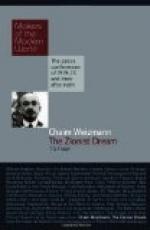|
This section contains 298 words (approx. 1 page at 300 words per page) |
World of Chemistry on Chaim Weizmann
Chaim Weizmann was born on November 17, 1874, in Motol, Russia. In 1885, he migrated to Pinsk to attend high school, where he spent his spare time in Zionist activities. He later became President of the World Zionist Organization in 1921, President of the Hebrew University in 1932, and served as first President of the new State of Israel from its establishment in 1948 to his death in 1952.
After obtaining his higher education in Germany (Darmstadt Polytechnic Institute, 1893-94; Charlottenburg Polytechnic Institute, 1893-97) and Switzerland (University of Fribourg, 1897-99; Ph.D. 1899), he taught as a Privat-Dozent (unsalaried lecturer) at the University of Geneva and carried out basic and applied research at Manchester University, supplemented by industrial research. Weizmann became a British citizen in 1910.
A quest for synthetic rubber led to Weizmann's classic work on fermentation as a source of acetone in 1915, which was urgently needed by the British government for the manufacture of cordite (smokeless powder) during World War I. At the behest of the First Lord of the Admiralty, Winston Churchill, Weizmann's discovery of the acid- resistant microorganism Clostridium acetobutylicum used in the Weizmann process was utilized on an enormous scale in England, Canada, and the United States. This rapid wartime expansion from research laboratories to facilities which focused on industry was not only unique among the use of microbiological processes. It was also the forerunner of the production of penicillin during World War II and biotechnological processes of the present.
The first diplomatic act of international recognition of Zionism, the Balfour Declaration (1917) came about largely as a result of Weizmann's scientific and political efforts. Weizmann pursued his scientific research, along with his political activities, until the end of his life. In his later years he worked at the Weizmann Institute of Science in Rehovot, Israel, where he died on November 9, 1952.
|
This section contains 298 words (approx. 1 page at 300 words per page) |


